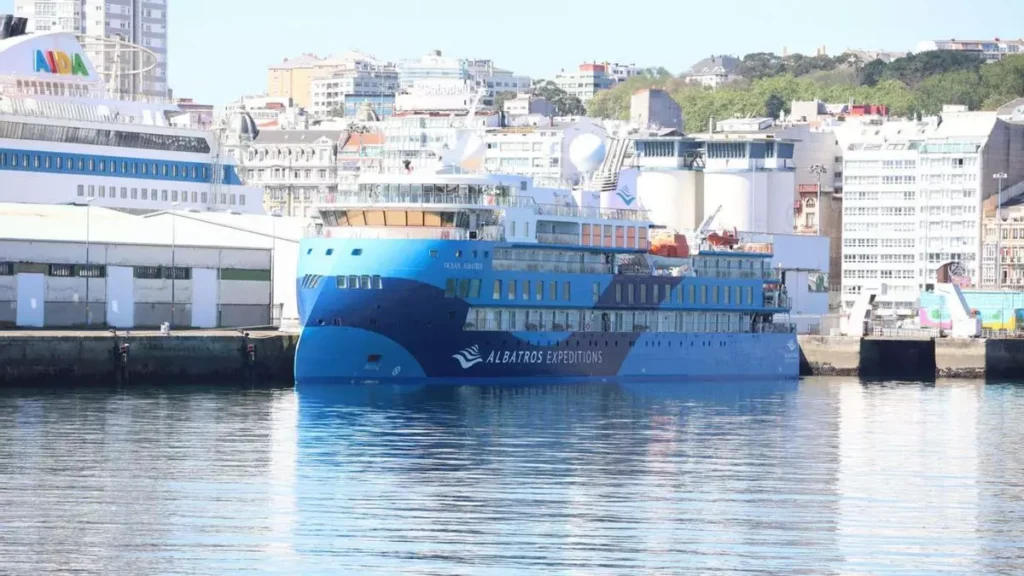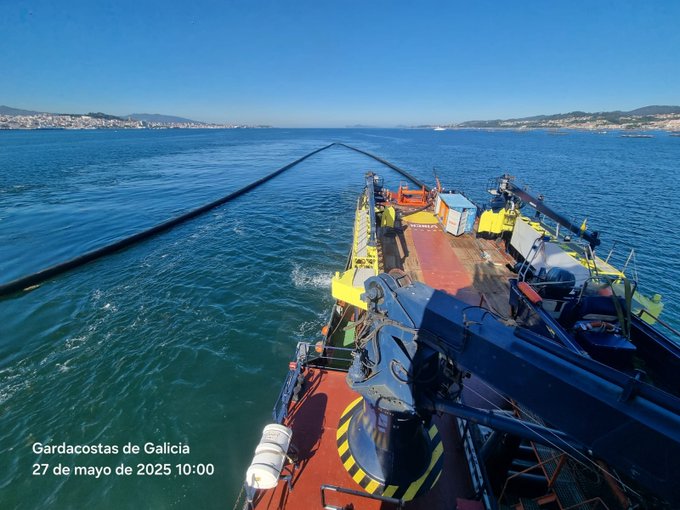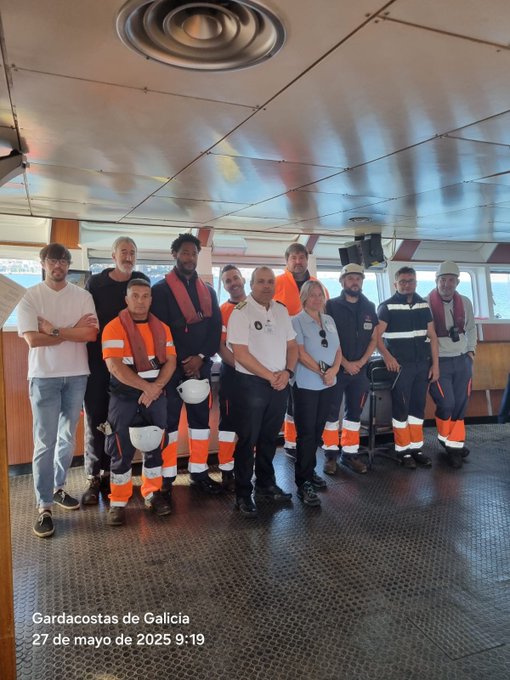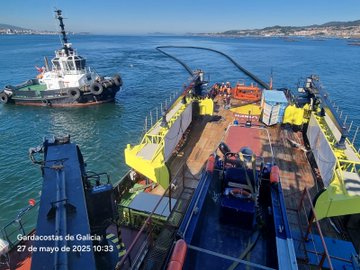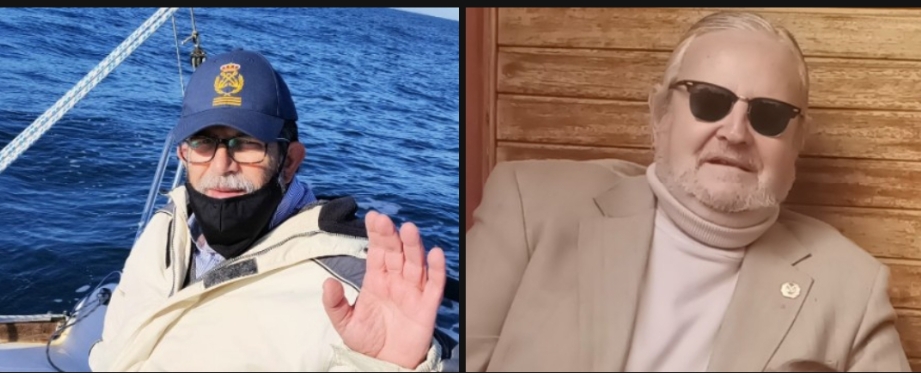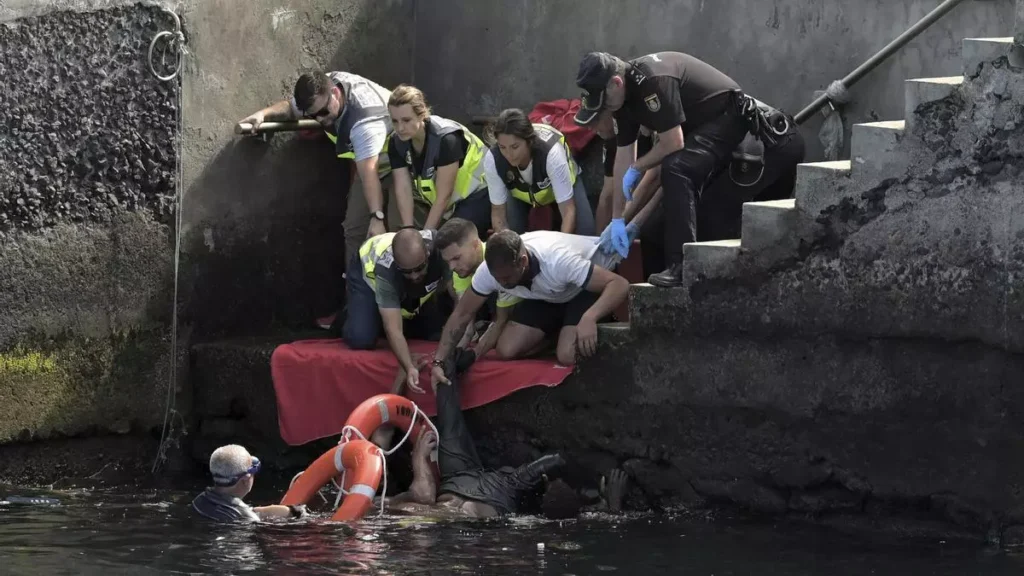«Ilustres ignorantes»
Viajeros incansables, poliédricos conferenciantes, aparentes Expertos de no se sabe que cosa, esto es lo que han conseguido.
El colapso del GMDSS en España.
Por mucho libro que escriban quedaran para la historia como «ídolos con los pies de barro».
Justificación
GMDSS
SERVICIOS EN LOS QUE DEBERÁN APOYARSE LAS NUEVAS TECNOLOGÍAS
BASE DE DATOS DE RADIOBALIZAS
Se contempla en el Reglamento de Radiocomunicaciones.
En relación con lo dispuesto en la regla 5-1 del capítulo IV del anexo del Convenio SOLAS, el órgano competente para la asignación de las identidades del servicio móvil marítimo (MMSI), para su programación en los equipos de llamada selectiva digital y en las radiobalizas por satélite respecto de los buques nacionales será la Dirección General de la Marina Mercante, que mantendrá una base de datos actualizada de dichas identidades permanentemente conectada con el Centro Nacional de Coordinación de Salvamento Marítimo (CNCS).
SISTEMA MARS PARA LLAMADA SELECTIVA DIGITAL
No se contempla en el Reglamento de Radiocomunicaciones, pero se encuentra especificada en:
Artículo 3. Definiciones – Punto “Y “
Los conceptos que no se encuentren expresamente definidos en este Reglamento, tendrán el significado previsto en la normativa de telecomunicaciones en vigor y, en su defecto, en el Reglamento de Radiocomunicaciones de la Unión Internacional de Telecomunicaciones (UIT) o en los convenios de la Organización Marítima Internacional (OMI).
En consecuencia es de aplicación:
Resolución 340 (CMR/97) UIT
Algunas administraciones y la Organización Marítima Internacional han expresado que necesitan información actualizada sobre las características de las estaciones de barco con mucha más regularidad de lo que ofrece actualmente la edición del Nomenclator de las Estaciones de Barco y sus suplementos…..
Esta información se considera absolutamente esencial para la identificación de los barcos en peligro, sobre todo ahora que el servicio mundial de socorro y seguridad marítimos utiliza como medio de identificación las identidades del servicio móvil marítimo asignadas a los barcos.
En respuesta a estas peticiones, la Oficina de Radiocomunicaciones ha creado y puesto en servicio un sistema de acceso y recuperación a distancia para la base de datos de estaciones de barco.
El Sistema de Acceso y Extracción en el Servicio Móvil Marítimo (MARS, maritime mobile access and retrieval system) es un sistema de información mediante interrogación a una base de datos en línea accesible a la comunidad marítima para consultar la base de datos de las estaciones de barco.
El sistema está destinado fundamentalmente a soportar el Sistema Mundial de Socorro y Seguridad Marítimos (SMSSM).
Se utiliza para identificar las estaciones de barco en peligro y, además, ofrece información pertinente sobre el buque que puede servir de ayuda para las actividades de salvamento.
El sistema también proporciona información relativa al servicio móvil marítimo de utilidad a la comunidad marítima.
Conviene señalar que el MARS, en cierto modo, en el futuro sustituirá al Nomenclátor de Estaciones de Barcos (Lista V). Las estaciones de barco tenían la obligación de llevar a bordo dicho Nomenclátor en la época de los antiguos sistemas de socorro y seguridad, pues proporcionaba a los barcos las características de otras estaciones de barco que se consideraban útiles para las tareas de salvamento. En la época actual del SMSSM se aprovecha al máximo la moderna tecnología y el MARS proporciona a los Centros de Coordinación de Salvamento (CRR) la misma información pero más rápidamente y en línea.
MASTER PLAN GMDSS MARZO 2007
La OMI, facilita periódicamente, información de la implementación a nivel mundial de las instalaciones y operatividad del Sistema Mundial de Socorro.
El Master Plan, es el solapamiento perfecto, para el Reglamento de Radiocomunicaciones.
La flota española, sobre todo la pesquera, faena por todos los caladeros del mundo.
Es de vital importancia, conocer en qué fase de implementación del Sistema Mundial de Socorro, se encuentran los países donde faenan.
Los Planes Integrales de Radiocomunicaciones para Buques Pesqueros, son un factor determinante para garantizar la Seguridad de la Vida Humana en la Mar.
El Centro Nacional de Radiocomunicaciones Marítimas de Madrid-Radio, es un auténtico baluarte para garantizar las radiocomunicaciones para caladeros internacionales.
Las coberturas facilitadas por las Estaciones Costeras en las Zonas A1- A2 – A3, contempladas en el Reglamento de Radiocomunicaciones, en ondas métricas, decamétricas y hectométricas, así como en Llamada Selectiva Digital, convierten a las estaciones costeras del Servicio Móvil Marítimo de Telefónica de España (Centros de Comunicaciones Radiomarítimas), en el mayor apoyo para las embarcaciones menores y de rías y flota pesquera faenando en caladeros nacionales e interna ENSEÑANZAS EXTRAÍDAS DE LA ELABORACIÓN Y PUESTA EN MARCHA DEL SISTEMA MUNDIAL DE SOCORRO
Para identificar las enseñanzas, es decir, las lecciones aprendidas, tendremos que recurrir a las investigaciones de naufragios y al comportamiento de los usuarios en los tres segmentos identificados como, marina mercante, pesca y recreo, utilizando para ello las conclusiones del :
SUBCOMITÉ DE RADIOCOMUNICACIONES Y BÚSQUEDA Y SALVAMENTO COMSAR 10 10º PERIODO DE SESIONES, 9 DE MARZO DE 2006
El Subcomité examinó:
a.- La complejidad del Sistema de Llamada Selectiva Digital.
b.- El proyecto de revisión sobre la asignación y el uso de las identidades del servicio móvil marítimo.
c.- La problemática de la detección por satélite de los mensajes del AIS.
d.- El Subcomité, deliberó sobre la mejor manera de mantener los procedimientos radiotelefónicos de socorro y seguridad en el Canal 16 de ondas métricas, que preceden al SMSSM y, que se recogen actualmente en el Apéndice 13 del Reglamento de Radiocomunicaciones.
5.- Servicios de INMARSAT.-
El Subcomité examinó un documento de Estados Unidos, en el que se formulan observaciones sobre el informe de la Organización Internacional de Telecomunicaciones Móviles por Satélite (IMSO) y se propone incluir información sobre el porcentaje de falsas alertas o sobre la tendencia al alza o baja de la falsas alertas en informes similares en el futuro, ya que resultarían de gran utilidad para el Subcomité, y donde también se considera útil contar con información más detallada sobre los números de casos reales de socorro transmitidos por el Sistema INMARSAT.
Las estadísticas disponibles de las operaciones del Servicio de Guardacostas de los Estados Unidos en el Atlántico, durante el período abarcado por el informe de la IMSO, demuestran que más del 95 % de las alertas recibidas por el Sistema INMARSAT, son falsas.
Tras examinar brevemente esta propuesta, el Subcomité, acordó que sería útil que los RCC, recopilaran y analizaran información sobre falsas alertas, de conformidad con lo dispuesto, donde se contemplan las orientaciones para recopilar datos sobre falsas alertas mediante los cuestionarios y formularios normalizados de notificación de uso voluntario.
6.- Servicio de COSPAS-SARSAT.-
El Subcomité acogió con agrado un documento, en el que se ofrece un breve informe sobre la situación del programa COSPAS-SARSAT, en particular sobre las operaciones del sistema, la situación de los segmentos espaciales y terrestres, la población de las radiobalizas, las estadísticas de falsas alertas, las interferencias en la banda de frecuencias de 406,0 406,1 MHz, los sistemas MEOSAR y el establecimiento por parte de la Secretaría de COSPAS SARSAT, de una base de datos internacional sobre radiobalizas de 406 MHz…..
El Grupo de Trabajo había observado que los sistemas existentes, incluidos COSPAS-SARSAT e INMARSAT, tienen un número importante de falsas alertas entre las alertas enviadas a los RCC.
Por consiguiente, el Grupo de Trabajo, recomendó al Subcomité, que invitara a los Gobiernos Miembros, a recopilar información de sus RCC, sobre el número de falsas alertas recibidas y sobre su opinión respecto a la eficacia de los sistemas de alerta actuales.
9.- Cuestiones urgentes que debe examinar el Comité Seguridad Marítima (MSC) 81.-
La Secretaría informó al Subcomité:
b.- Del reconocimiento, por parte del Subcomité STW 37 (Titulación, Formación y Guardias para Gente de la Mar) de la existencia de un problema real de carencia de capacitación en relación con los Operadores del SMSSM y que la solución a largo plazo de este problema podría lograrse mediante la normalización del equipo y de los procedimientos de funcionamiento.
Como solución inmediata, el Subcomité STW (Formación, Titulación y Guardias para Gente de la Mar), preparó una circular para el Comité de Seguridad Marítima (MSC) para promover y verificar la familiarización continuada de los operadores del SMSSM a bordo de los buques e invitó al Comité de Seguridad Marítima (MSC) a que lo aprobara.
RECOMENDACIONES OPORTUNAS EN LO QUE RESPECTA A LA LABOR FUTURA Y ORIENTACIONES SOBRE EL SISTEMA MUNDIAL DE SOCORRO
EL SISTEMA MUNDIAL DE SOCORRO Y LAS OPERACIONES DE BUSQUEDA Y RESCATE (GMDSS / SAR)
El Convenio SAR de 1979, fue proyectado con el objetivo de facilitar un sistema mundial para responder ante emergencias, mientras que el Sistema Mundial de Socorro, se creó con el objetivo de facilitarle apoyo con unas comunicaciones eficaces e imprescindibles para su éxito.
El Sistema Mundial de Socorro y el Convenio SAR, son importantísimos para la seguridad marítima y están proyectados para garantizar que toda emergencia marítima sea respondida de forma eficaz.
En consecuencia, es prioritario tener muy en cuenta los siguientes conceptos :
1.- Escucha Canal 16:
El Sistema Mundial de Socorro, basa su eficacia en los canales y frecuencias analógicos
2.- Código Alfanumérico Hexadecimal:
El responsable de la guardia de navegación y/o radiocomunicaciones, debe ser consciente de lo que ocurre una vez activada una Radiobaliza, manual o automáticamente.
3.- Una Radiobaliza, no produce ningún tipo de retraso en la decodificación de sus datos, sino que es un proceso científicamente controlado por los satélites Leosar y Geosar.
4.- La perfecta comprensión del ciclo de una Radiobaliza:
a.- Activación.
b.- Container balsa salvavidas.
c.- Metodología balsa salvavidas: Resart y Equipo VHF.
5.- Tiempos de respuesta:
a.- De los buques en la mar.
b.- De los medios activados desde tierra.
6.- Una vez implementado el Sistema Mundial de Socorro, en la Marina Civil española:
a.- Los responsables de las guardias de navegación, deberán tener los conceptos muy claros respecto a trasladar a la balsa salvavidas, los equipos Resart y VHF Bidireccional.
b.- La unificación de criterios, en aras a salvaguardar la vida humana en la mar, pasa por optimizar todos y cada uno de los subsistemas y métodos del Sistema Mundial de Socorro.
7.- La eficacia de la incorporación del GPS a la Radiobaliza de 406 Mhz :
a.- Posición GPS actualizadas cada veinte minutos.
b.- El error en distancia, pasa a ser de cero a 15/30 metros.
c.- Con o sin GPS, los tiempos de respuesta para la recogida de náufragos la determinarán los buques en las cercanías de la posición de la Radio Baliza, caso de tener las escuchas abiertas.
CONFERENCIA MUNDIAL DE RADIO COMUNiCACIONES
El punto más importante del orden del día, en lo que respecta a los servicios marítimos de la CMR-07 fue el punto 1.14:
» Examinar los procedimientos de funcionamiento y los requisitos del sistema mundial de socorro y seguridad marítimos (SMSSM) y otras disposiciones conexas del Reglamento de Radiocomunicaciones, así como la continua evolución hacia el SMSSM, la experiencia obtenida desde su introducción y las necesidades de todas las clases de barcos”.
ELABORACIÓN DE UNA ESTRATEGIA
Al amparo de las Actas Finales de la Conferencia Mundial de Radiocomunicaciones ( CMR 07 ) y del Subcomité de Radiocomunicaciones, Búsqueda y Salvamento ( COMSAR 12 ) y con la validación del Comité de Seguridad Marítima ( MSC 84 ) respecto a minimizar los tiempos de respuesta en los salvamentos se deberían considerar los siguientes Criterios de Alto Nivel recogidos en OMI :
1.- Elaboración de unos Principios Estratégicos para minimizar los tiempos de respuesta en los salvamentos y salvaguardar la seguridad de la vida humana en la mar.
2.- Armonizar Criterios de Alta Prioridad basados en la Resolución A.814(19) y circulares MSC/Circ.861 y MSC/Circ.862 de la OMI.
3.- Hacer un seguimiento específico sobre los Resultados Previstos.
4.- Tomar en consideración las Medidas que deberán adoptarse:
COMSAR 12 DE OMI
LA NOTA PRESENTADA POR LA REPUBLICA DE COREA
UN GRAN EJEMPLO A TENER EN CUENTA1 Con la introducción del Sistema mundial de socorro y seguridad marítima (SMSSM), se produjo una transición importante en el modo de transmisión de las comunicaciones de socorro,ya que se pasó de la radiotelefonía a la transmisión automática mediante equipo tal como el de llamada selectiva digital (DSC) y radiobaliza de localización de siniestros satelitaria (RLS).
Por alguna razón, posiblemente debido a las nuevas tecnologías de los sistemas de transmisión de alertas de socorro, el número de casos de falsos alertas de socorro ha aumentado considerablemente.
2 El número excesivo de falsos alertas de socorro impone una carga importante e innecesaria a los centros coordinadores de salvamento (RCC) y podría tener repercusiones graves en situaciones reales de socorro que, como resultado, podrían agravarse.
ANTECEDENTESTras tomar nota de que los falsos alertas de socorro se están convirtiendo en un obstáculo importante para el funcionamiento eficaz de los servicios de búsqueda y salvamento, la Asamblea adoptó el 23 de noviembre de 1995 la resolución A.814(19), Directrices para evitar falsos alertas de socorro.
Asimismo, las circulares MSC/Circ.861, Medidas para reducir el número de falsos alertas de socorro, y MSC/Circ.862, Aclaración de ciertas prescripciones de la norma defuncionamiento de la OMI para el equipo del SMSSM, fueron aprobadas y distribuidas por el Comité en su 69º periodo de sesiones, celebrado en 1998.
Incluso tras la difusión y la implantación de estas decisiones, no se ha reducido el número de falsos alertas de socorro, lo que menoscaba los esfuerzos realizados por la Organización durante los últimos 10 años.
Por lo tanto, es necesario realizar estudios más profundos sobre los falsos alertas de socorro a fin de reducir, o mejor aún, eliminar, los riesgos y peligros que entrañan para el desarrollo de sistemas de navegación electrónica más precisos en el futuro.
Análisis estadísticos de los alertas de socorro
Del número total de alertas de socorro recibidos por el RCC de la República de Corea entre 2004 y 2006, el 9% fueron alertas de socorro reales transmitidos desde buques que se hallaban en situaciones reales de peligro.
El 91% restante resultaron ser falsos alertas o alertas de socorro sin identificar.
MEDIDAS PARA REDUCIR EL NÚMERO DE FALSOS ALERTAS
A fin de reducir o, mejor aún, evitar las transmisiones de falsos alertas de socorro, es necesario examinar a fondo los siguientes aspectos:
Debe establecerse por escrito un procedimiento y método de funcionamiento unificado para iniciar los alertas de socorro a fin de crear unas normas de funcionamiento normalizadas para los usuarios del equipo;
Debería adoptarse un enfoque institucional con miras a la reducción de falsos alertas para garantizar el funcionamiento eficaz de los servicios SAR.
A fin de reducir al mínimo o, mejor aún, eliminar los riesgos de confusión para los usuarios y de dotar al mismo tiempo de más precisión a los futuros sistemas de navegación electrónica, es necesario examinar a fondo la cuestión con objeto de evitar o reducir el número de falsos alertas de socorro.
Determinación de las necesidades de los usuarios
Recopilación, integración, intercambio, presentación y análisis de manera armonizada de la información marítima a bordo y en tierra por medios electrónicos.
Posteriormente se añadió una sexta categoría, que abarca cuestiones relativas al factor humano para abordar aspectos tales como la motivación, compromiso, formación, normalización y ergonomía.
Comunicaciones eficaces y fiables en los buques y en tierra:
Se expresó claramente la necesidad de contar con unos medios eficaces y fiables de
comunicación entre los usuarios a bordo y en tierra.
Las autoridades en tierra necesitan medios eficaces de comunicación con los buques para facilitar información operativa y sobre seguridad,
Las comunicaciones con los buques y entre éstos han de
ser eficaces, utilizar óptimamente las ayudas audio/visuales y las frases
normalizadas, reducir al mínimo las dificultades lingüísticas y reducir al mínimo las distracciones.
CRITERIOS DE ALTA PRIORIDAD Orientaciones OMI:
Obligaciones de los Estados en virtud del Convenio SAR y otros instrumentos internacionales.
La OMI, a través de sus Circulares, pretende orientar a los Estados con el fin de reducir los retrasos en la búsqueda y salvamento a los alertas de socorro, y en particular a los
alertas de socorro recibidos por el sistema COSPAS-SARSAT.
En ellas se recuerda a los Estados las obligaciones que tienen en virtud del Convenio SAR y otros instrumentos internacionales pertinentes.
3.- Grupo de Expertos del Sistema Mundial de Socorro:
Lejos de dar protagonismo a los usuarios, profesionales de la mar y armadores, la Consellería de Pesca y Asuntos Marítimos, debería constituir con carácter de urgencia un Grupo de Expertos del Sistema Mundial de Socorro, para investigar de facto los accidentes y naufragios.
Del mismo modo, crearía un Registro de Incidencias, donde quedarían contempladas las lecciones aprendidas y las medidas correctoras.
Las nuevas tecnologías permiten, en cuestión de horas, obtener todos los datos relativos al Sistema Mundial de Socorro.
Las Conclusiones del Grupo de Expertos del SMSSM serían notificadas a un Grupo Mixto de Trabajo del Sector Pesquero, para la aplicación de medidas correctoras inmediatas.
Debería contarse, dentro del Grupo Mixto de Trabajo, con representantes de la Náutica de Recreo.
La Náutica de Recreo, está tutelada por el RD 1185/2206, en lo que respecta a implementación y metodología del SMSSM.
No debe olvidarse el altísimo grado de incidencias generadas por la Náutica de Recreo.
4.- Epígrafe XII:
Subcomisión del Prestige, Congreso de los Diputados.
Como solución inmediata para la seguridad de la vida humana en el mar
y siguiendo las directrices del Subcomité de Formación y Guardias
(STW) en sus sesión número 37 celebrada en Londres, del 23 al 27 de
enero de 2006, y al amparo de los Protocolos nacionales e
internacionales y del Reglamento de Radiocomunicaciones que regula a
la flota pesquera, sería preciso que el Ministerio de Fomento
promoviese y verificase la continua adaptación de los operadores del
Sistema Mundial de Socorro (GMDSS) en los buques pesqueros.
Para ello, y partiendo de los cuestionarios del Memorando de Paris
para la mejora de las comunicaciones en los buques mercantes,debería
seleccionarse, con carácter inmediato, a un equipo de oficiales
radioelectrónicos de la Marina Mercante, cualificados y expertos, a
fin de llevarlo a efecto en los barcos pesqueros situados en los
puertos de las distintas Comunidades Autónomas.
En este sentido, resulta pertinente rememorar algunas de las
conclusiones contenidas en el Informe de la Subcomisión sobre las
consecuencias derivadas del hundimiento del Prestige, documento
aprobado en el Congreso el 28 de junio del pasado 2006.
En concreto, en el apartado XII relativo a Conclusiones y propuestas sobre la
mejora de la seguridad marítima, se enumeran una serie de medidas de
este calado que reproducimos a continuación:
«23. Es necesario aplicar las recomendaciones de los grupos de trabajo
del Subcomité de Radiocomunicaciones y de Búsqueda y Salvamento
COMSAR 10, celebrado recientemente en Londres.
Se propone recortar los tiempos de respuesta de los medios desalvamento en casos de temporales, o en época de verano en costas de
alta densidad de flota de recreo o deportiva.
Se debe iniciar un amplio estudio, a cargo de profesionalesindependientes y de probada reputación, que indaguen las causas y
circunstancias de los hundimientos y demás siniestros padecidos por
buques pesqueros a lo largo de los últimos diez años, con especial
incidencia en aquellos casos en que se produjeron pérdidas de vidas
humanas. Asimismo, y en las mismas condiciones, deberá abordar una
amplia campaña de estudio en orden a determinar el grado del
cumplimiento de la vigente normativa en materia de seguridad e higiene
laboral en el ámbito de la actividad pesquera.
Se deben adoptar las iniciativas legales y las reformasadministrativas necesarias para asegurarse de que las decisiones
náuticas en materia de seguridad marítima en las empresas navieras y
en la Administración sean llevadas a cabo por profesionales de la mar
debidamente experimentados y capacitados de acuerdo a las
disposiciones del Convenio STCW 78/95.
Se propone elevar las exigencias de seguridad en la flota pesqueray de recreo mediante normativa específica,
PROPOSICION NO DE LEY
El Congreso de los Diputados insta al Gobierno-Ministerio de Fomento
a:
Promover y verificar la continua adaptación de los operadores del
Sistema Mundial de Socorro (GMDSS) en los buques pesqueros.
En este sentido, seleccionar, cuanto antes, a un equipo de técnicos
cualificados, especialmente radioelectrónicos de la Marina Mercante,
para efectivizar tal tarea en los barcos pesqueros situados en los
distintos puertos.
Llevar a cumplimiento íntegro el epígrafe XII del Informe de
conclusiones elaborado por la Subcomisión sobre las consecuencias
derivadas del hundimiento del Prestige y aprobado por el Congreso, en
lo relativo a la mejora de la seguridad marítima.
5.- Certificados Long and Short:
Una de las grandes demandas del sector pesquero es la flexibilización de los cursos de especialización.
La DGMM, ha obviado, a pesar de estar programado en el Centro Jovellanos, los cursos para la obtención de los Certificados Long and Short Range Certificates, más adecuados a la formación profesional del sector pesquero y con menos horas lectivas.
La adopción de estos Cursos, sería un gran logro para la Consellería de Pesca y Asuntos Marítimos, por la favorable acogida que tendría en el sector pesquero.
Operador General del SMSSM para Embarcaciones «No SOLAS»
GMDSS Long Range Certificate (LRC)
Colectivo:
Dirigido a titulados y profesionales de la Marina Mercante, Náutico-
Pesquera y Náutica de Recreo, que naveguen en embarcaciones No
SOLAS (pesqueros de menos de 24 m. de eslora y buques de recreo) en
cualquiera de las áreas marítimas y con equipos del SMSSM.
Formación:
Capacita a los alumnos en el manejo de los equipos de
radiocomunicaciones del SMSSM en embarcaciones no sujetas al convenio
SOLAS.
La necesidad de esta formación y certificación para embarcaciones No Solas,
está referenciada en la siguiente normativa:
CEPT/ERC*/Recommendation 31-05 E (Bonn 1994)
European Conference of Postal and TelecommunicationsAdministrations
** European Radiocommunications Committee
Resolución ITU 343 (CMR 97)
Reglamento Internacional de Radiocomunicaciones, artículos 47 y 48.
Prácticas:
Las prácticas ocupan un 70% de la carga lectiva y se realizan en el
simulador SMSSM.
Duración:
El curso se desarrolla durante cinco jornadas.
Módulo:
Se imparte a grupos de seis alumnos.
6.- Resolucion OMI y Circulares :
La Consellería de Pesca y Asuntos Marítimos debería estar familiarizada con la Resolución A.814(19) que marca las directrices para evitar falsos alertas de socorro.
También con las circulares MSC/Circ.861 que establece las medidas para reducir el número de falsos alertas de socorro, y MSC/Circ.862 sobre la aclaración de ciertas prescripciones de la norma de funcionamiento de la OMI para el equipo del SMSSM.
7.- Master Plan GMDSS.
El Plan Maestro del Sistema Mundial de Socorro, es la llave maestra para una navegación segura.
No debe caer en el olvido que, el Sistema, es Mundial.
El estado descriptivo de las estaciones terrenas que facilita el Master Plan, garantiza la seguridad de la vida humana en la mar, caso de accidente o naufragio, en cualquier parte del mundo.
Presenta cuestionarios sobre Bases de Datos.
8.- La continua evolución del SMSSM:
La Consellería de Pesca y Asuntos Marítimos, debería tener en consideración el mensaje de la Conferencia Mundial de Radiocomunicaciones 2007:
» Examinar los procedimientos de funcionamiento y los requisitos del sistema mundial de socorro y seguridad marítimos (SMSSM) y otras disposiciones conexas del Reglamento de Radiocomunicaciones, así como la continua evolución hacia el SMSSM, la experiencia obtenida desde su introducción y las necesidades de todas las clases de barcos”.
9.- Medidas coercitivas y rango sancionador.
El Real Decreto 2062/1999, de 30 de diciembre ( BOE de 21 de enero de
2001 ) por el que se regula el nivel mínimo de formación en
profesiones marítimas, habilita en su disposición final sobre
formación, al personal de los buques pesqueros, especialmente en
materia de lucha contra incendios, salvamento, supervivencia,
prevención de accidentes y comunicaciones.
En consecuencia y de conformidad con la normativa internacional y
nacional citada, resulta preciso actualizar y refundir en una misma
disposición la formación especial del personal de los buques
mercantes y de pesca en materia de especialidad.
La Orden FOM 2296/2002, de 4 de septiembre, regula los programas de
formación de los títulos profesionales de Marineros de Puente y de
Máquinas de la Marina Mercante y de Patrón Portuario, así como los
certificados de especialidad acreditativos de la competencia
profesional…
La Resolución del Parlamento Europeo sobre Pesca: seguridad y causas
de accidentes ( 2000/2028 (INI) en sus numerosos considerándoos dice
entre otras cosas:
A.- Considerando muy preocupantes e inaceptables las cifras en la UE,
tanto de accidentes a bordo de los buques como de siniestros sufridos
por las propias embarcaciones y que estos se reducirían
considerablemente con la aplicación rigurosa por parte de las
administraciones y del propio sector de la normativa vigente relativa
a la seguridad.
B – Reclama la aplicación de sanciones y la verificación de los
medios de comunicación a bordo.
C -Pide a la Comisión que aclare, sin ambigüedades, y dé a conocer
las responsabilidades de los patrones/armadores en materia de
seguridad de su tripulación, a la luz de las directivas europeas
existentes.
D-Pide a la Comisión que obligue a los Estados miembros a
establecer una base de datos informática de servicios de salvamento
para garantizar que se previene de manera automática a todos los
armadores de buques pesqueros para que realicen un mantenimiento
anual de sus equipos de salvamento, así como un sistema similar de
recordatorio para las baterías de RBLS (radiobalizas) y del
respondedor SAR.
F .- Reclama una mayor coordinación entre centros y servicios de
comunicación marítima, incrementando y modernizando para ello sus
medios técnicos y humanos actuales, y entre los centros radiomédicos
europeos para facilitar el intercambio de información permanente, en
tiempo real, sobre asistencia médica, tal como prevé la Directiva
92/29/CEE, con el fin de mejorar las técnicas de radiodiagnóstico y
de telemedicina, así como el salvamento marítimo ; esto podría
llevarse a cabo mediante planes piloto específicos.
Código de Identificación Alfanumérico Hexadecimal.
Se compone de quince caracteres:
Nombre, dirección y teléfono del propietario de la baliza;
Número principal y secundario de teléfonos de emergencia durante las 24 horas;
Nombre del barco o señal de llamada de la aeronave;
Tipo de barco o aeronave con características de identificación;
Puerto de base o aeropuerto primario y equipo de comunicaciones.
Cuando una baliza de 406 MHZ es detectada por el Sistema COSPAS-SARSAT, la información contenida en la base de datos de registro es un complemento al mensaje
de datos de alerta.
La información de la base de datos de registro combinada con los datos de posición
provenientes de una baliza reducen el tiempo de respuesta y aumentan el éxito de cada búsqueda.
Adicionalmente, la información en la base de datos de registro ha sido una herramienta sumamente valiosa para silenciar las activaciones falsas, SIN GASTAR LOS RECURSOS SAR.
En la mayoría de casos, el RCC puede llamar al propietario, o a los números de emergencia principal o secundario, para establecer el paradero conocido de un barco o una aeronave cuyo registro de baliza de 406 MHZ está transmitiendo.
Si el barco no está navegando o la aeronave volando, el propietario puede desactivar las transmisiones inadvertidas de las balizas yendo al barco o a la aeronave y apagando la
baliza.
Fdo
Anton Salgado/Luis Milian
Coordinadores

